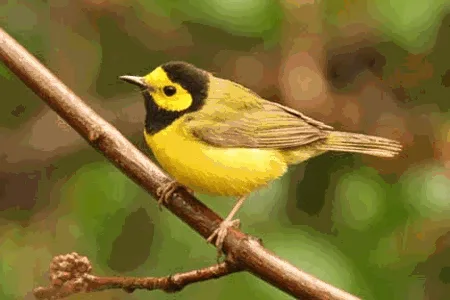
Hooded Warbler
[order] PASSERIFORMES | [family] Parulidae | [latin] Wilsonia citrina | [UK] Hooded Warbler | [FR] Sylvette a capuchon | [DE] Kapuzen-Waldsanger | [ES] Reinita encapuchada | [NL] Monnikszanger
Subspecies
Monotypic species
Physical charateristics
Close in size to Blackpoll Warbler but with proportionately slightly shorter wings and noticeably longer tail; averages 10% larger than Yellow Warbler. Quite large, lengthy, Nearctic wood warbler fond of moist woodland. Bright olive to greenish-brown above and yellow below; male has black hood around yellow face. Often spreads tail to show white panels on outer feathers.
Listen to the sound of Hooded Warbler
[audio:http://www.aviflevoland.nl/sounddb/H/Hooded Warbler.mp3]
Copyright remark: Most sounds derived from xeno-canto
| wingspan min.: | 20 | cm | wingspan max.: | 22 | cm |
| size min.: | 12 | cm | size max.: | 14 | cm |
| incubation min.: | 12 | days | incubation max.: | 13 | days |
| fledging min.: | 8 | days | fledging max.: | 13 | days |
| broods: | 1 | eggs min.: | 3 | ||
| eggs max.: | 5 |
Range
North America : East, Southeast
Habitat
Breeds in temperate and subtropical zones of eastern Nearctic, mainly in lowland woods or scrub, living in dense lower layers of vegetation, but not often seen on ground. Generally favours moist mature woodland.
Reproduction
Both male and female W. citrina sing during the process of attracting a mate. While birds will form pairs for mating purposes, it is frequently found that a mother’s eggs have been fertilized by a neighboring male.
The female constructs a nest in the underbrush of a low lying area. The nest is constructed of bark and plant material, with an outer layer of dead leaves. Three to five eggs are laid, then normally incubated for about twelve days before hatching. After hatching, the chicks will fledge in about eight or nine days and continue their growth into adult birds. Juvenile birds will be capable of reproduction the next breeding season.
The female constructs a nest in the underbrush of a low lying area. The nest is constructed of bark and plant material, with an outer layer of dead leaves. Three to five eggs are laid, then normally incubated for about twelve days before hatching. After hatching, the chicks will fledge in about eight or nine days and continue their growth into adult birds. Juvenile birds will be capable of reproduction the next breeding season.
Feeding habits
Wilsonia citrina feeds primarily on small insects, spiders and other arthropods, either catching them while in flight or picking them off of forest vegetation.
Conservation
This species has an extremely large range, and hence does not approach the thresholds for Vulnerable under the range size criterion (Extent of Occurrence <20,000 km2 combined with a declining or fluctuating range size, habitat extent/quality, or population size and a small number of locations or severe fragmentation). The population trend appears to be increasing, and hence the species does not approach the thresholds for Vulnerable under the population trend criterion (>30% decline over ten years or three generations). The population size is extremely large, and hence does not approach the thresholds for Vulnerable under the population size criterion (<10,000 mature individuals with a continuing decline estimated to be >10% in ten years or three generations, or with a specified population structure). For these reasons the species is evaluated as Least Concern.

Migration
Short-distance migrant, with breeding and winter ranges separated by only 600-700 km in west (eastern Texas to northern Mexico). Winters from north-east Mexico south to Panama, with small numbers in Caribbean. Movement is across western Gulf of Mexico to eastern and southern Mexico, and only a few appear in peninsular Florida and Bahamas. Early migrants often overshoot or drift offshore, and in many years small numbers appear on islands around Nova Scotia, 600 km or more north-east and downwind from breeding range; many such in April or September.
Distribution map

